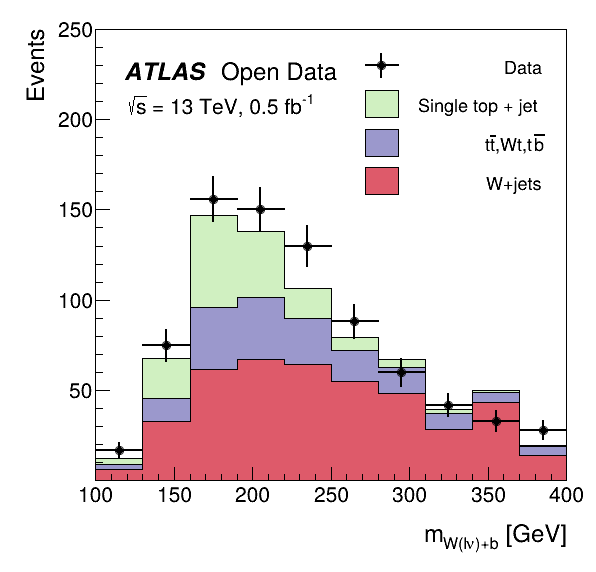This tutorial is the analysis of single top production adapted from the ATLAS Open Data release in 2020 (http://opendata.atlas.cern/release/2020/documentation/). The data was recorded with the ATLAS detector during 2016 at a center-of-mass energy of 13 TeV. Top quarks with a mass of about 172 GeV are mostly produced in pairs but also appear alone, dominantly from the decays of a W boson in association with a light jet.
The analysis is translated to a RDataFrame workflow processing up to 60 GB of simulated events and data. By default the analysis runs on a preskimmed dataset to reduce the runtime. The full dataset can be used with the –full-dataset argument and you can also run only on a fraction of the original dataset using the argument –lumi-scale.
import ROOT
import sys
import json
import argparse
import os
help="Run only on a fraction of the total available 10 fb^-1 (only usable together with --full-dataset)")
help="Use the full dataset (use --lumi-scale to run only on a fraction of it)")
parser.add_argument(
"-t", action=
"store_true", default=
False, help=
"Use implicit multi threading (for the full dataset only possible with --lumi-scale 1.0)")
if 'df107_SingleTopAnalysis.py' in sys.argv[0]:
else:
lumi = 10064.0
print(
'Run on data corresponding to {:.1f} fb^-1 ...'.
format(lumi * lumi_scale / 1000.0))
if args.full_dataset: dataset_path =
"root://eospublic.cern.ch//eos/opendata/atlas/OutreachDatasets/2020-01-22"
else: dataset_path = "root://eospublic.cern.ch//eos/root-eos/reduced_atlas_opendata/singletop"
df = {}
xsecs = {}
sumws = {}
samples = []
for p in processes:
for d in files[p]:
folder = d[0]
sample = d[1]
xsecs[sample] = d[2]
sumws[sample] = d[3]
num_events = d[4]
df[sample] = df[sample].
Range(
int(num_events * lumi_scale))
using cRVecF = const ROOT::RVecF &;
using cRVecI = const ROOT::RVecI &;
int FindGoodLepton(cRVecI goodlep, cRVecI type, cRVecF lep_pt, cRVecF lep_eta, cRVecF lep_phi, cRVecF lep_e, cRVecF trackd0pv, cRVecF tracksigd0pv, cRVecF z0)
{
int idx = -1; // Return -1 if no good lepton is found.
for(auto i = 0; i < type.size(); i++) {
if(!goodlep[i]) continue;
if (type[i] == 11 && abs(lep_eta[i]) < 2.47 && (abs(lep_eta[i]) < 1.37 || abs(lep_eta[i]) > 1.52) && abs(trackd0pv[i] / tracksigd0pv[i]) < 5) {
const ROOT::Math::PtEtaPhiEVector p(lep_pt[i], lep_eta[i], lep_phi[i], lep_e[i]);
if (abs(z0[i] * sin(p.Theta())) < 0.5) {
if (idx == -1) idx = i;
else return -1; // Accept only events with exactly one good lepton
}
}
if (type[i] == 13 && abs(lep_eta[i]) < 2.5 && abs(trackd0pv[i] / tracksigd0pv[i]) < 3) {
const ROOT::Math::PtEtaPhiEVector p(lep_pt[i], lep_eta[i], lep_phi[i], lep_e[i]);
if (abs(z0[i] * sin(p.Theta())) < 0.5) {
if (idx == -1) idx = i;
else return -1; // Accept only events with exactly one good lepton
}
}
}
return idx;
}
""")
for s in samples:
df[s] = df[s].Filter("trigE || trigM")\
.Filter("met_et > 30000")
df[s] = df[s].Define("goodlep", "lep_isTightID && lep_pt > 35000 && lep_ptcone30 / lep_pt < 0.1 && lep_etcone20 / lep_pt < 0.1")\
.Filter("ROOT::VecOps::Sum(goodlep) > 0")
df[s] = df[s].Define("idx_lep", "FindGoodLepton(goodlep, lep_type, lep_pt, lep_eta, lep_phi, lep_E, lep_trackd0pvunbiased, lep_tracksigd0pvunbiased, lep_z0)")\
.Filter("idx_lep != -1")
df[s] = df[s].Define("mtw", "sqrt(2 * lep_pt[idx_lep] * met_et * (1 - cos(lep_phi[idx_lep] - met_phi)))")\
.Filter("mtw > 60000")
df[s] = df[s].Filter("ROOT::VecOps::Sum(jet_pt > 30000 && abs(jet_eta) < 2.5) > 0")
df[s] = df[s].Define("goodjet", "jet_pt > 60000 || abs(jet_eta) > 2.4 || jet_jvt > 0.59")\
.Filter("ROOT::VecOps::Sum(goodjet) == 2")\
.Define("goodbjet", "goodjet && jet_MV2c10 > 0.8244273")\
.Filter("ROOT::VecOps::Sum(goodbjet) == 1")\
.Define("idx_tagged", "ROOT::VecOps::ArgMax(goodjet && goodbjet)")\
.Define("idx_untagged", "ROOT::VecOps::ArgMax(goodjet && !goodbjet)")
df[s] = df[s].Filter("abs(jet_eta[idx_untagged]) > 1.5 && abs(jet_eta[idx_tagged] - jet_eta[idx_untagged]) > 1.5")\
.Filter("lep_pt[idx_lep] + jet_pt[idx_tagged] + jet_pt[idx_untagged] + met_et > 195000")
for s in samples:
if "data" in s:
df[s] = df[s].Define("weight", "1.0")
else:
if "single" in s: stop_norm = "mcWeight / abs(mcWeight)"
else: stop_norm = "mcWeight"
df[s] = df[s].Define(
"weight",
"scaleFactor_ELE * scaleFactor_MUON * scaleFactor_LepTRIGGER * scaleFactor_PILEUP * scaleFactor_BTAG * {} * {} / {} * {}".
format(stop_norm, xsecs[s], sumws[s], lumi))
float ComputeTopMass(float lep_pt, float lep_eta, float lep_phi, float lep_e, float jet_pt, float jet_eta, float jet_phi, float jet_e, float met_et, float met_phi)
{
const ROOT::Math::PtEtaPhiEVector lep(lep_pt / 1000.0, lep_eta, lep_phi, lep_e / 1000.0);
const ROOT::Math::PtEtaPhiEVector met(met_et / 1000.0, 0, met_phi, met_et / 1000.0);
const ROOT::Math::PtEtaPhiEVector bjet(jet_pt / 1000.0, jet_eta, jet_phi, jet_e / 1000.0);
// Please note that we treat here the missing transverse energy as the neutrino, even though the z component is missing!
return (lep + met + bjet).M();
}
""")
histos = {}
for s in samples:
df[s] = df[s].Define("top_mass", "ComputeTopMass(lep_pt[idx_lep], lep_eta[idx_lep], lep_phi[idx_lep], lep_E[idx_lep], jet_pt[idx_tagged], jet_eta[idx_tagged], jet_phi[idx_tagged], jet_E[idx_tagged], met_et, met_phi)")
histos[s] = df[s].Histo1D(
ROOT.RDF.TH1DModel(
"top_mass",
"", 10, 100, 400),
"top_mass",
"weight")
h = None
t = histos[d[1]].GetValue()
return h
[wjets, twtb, singletop],
[(222, 90, 106), (155, 152, 204), (208, 240, 193)]):
text.DrawLatex(0.21, 0.80,
"#sqrt{{s}} = 13 TeV, {:.1f} fb^{{-1}}".
format(lumi * lumi_scale / 1000.0))
print("Saved figure to df107_SingleTopAnalysis.png")
ROOT::Detail::TRangeCast< T, true > TRangeDynCast
TRangeDynCast is an adapter class that allows the typed iteration through a TCollection.
Option_t Option_t TPoint TPoint const char GetTextMagnitude GetFillStyle GetLineColor GetLineWidth GetMarkerStyle GetTextAlign GetTextColor GetTextSize void char Point_t Rectangle_t WindowAttributes_t Float_t Float_t Float_t Int_t Int_t UInt_t UInt_t Rectangle_t Int_t Int_t Window_t TString Int_t GCValues_t GetPrimarySelectionOwner GetDisplay GetScreen GetColormap GetNativeEvent const char const char dpyName wid window const char font_name cursor keysym reg const char only_if_exist regb h Point_t winding char text const char depth char const char Int_t count const char ColorStruct_t color const char Pixmap_t Pixmap_t PictureAttributes_t attr const char char ret_data h unsigned char height h Atom_t Int_t ULong_t ULong_t unsigned char prop_list Atom_t Atom_t Atom_t Time_t format
ROOT's RDataFrame offers a modern, high-level interface for analysis of data stored in TTree ,...
A struct which stores the parameters of a TH1D.


